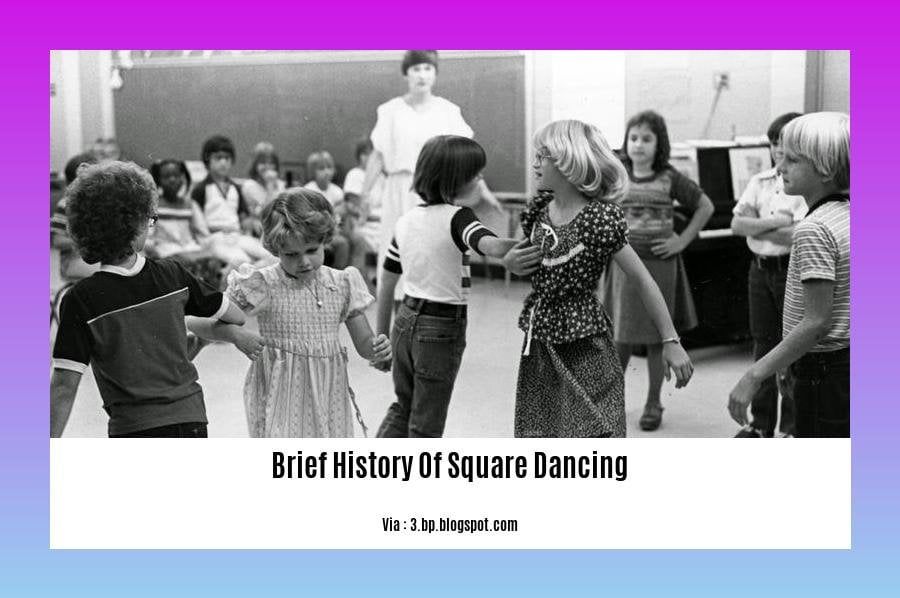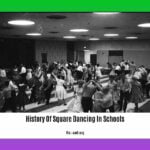Embark on a captivating journey through the annals of American folk dance in [A Brief History of Square Dancing]. Join us as we uncover the intricate origins, dynamic evolution, and enduring legacy of this beloved tradition. From its humble beginnings in frontier settlements to its vibrant presence in modern-day dance halls, square dancing has woven itself into the fabric of American culture.
Key Takeaways:
- Square dancing originated in Europe and was brought to America by settlers.
- It became popular in the U.S. in the 19th century.
- There are three main styles of square dancing: traditional, modern Western, and contemporary.
- Live music often accompanies square dancing.
- Dancers perform in square formations and follow calls and cues for specific movements.
Brief History Of Square Dancing

Prepare to swing your pardner in this brief history of square dancing. This lively folk dance has captivated Americans for centuries, with its origins tracing back to Europe. In the 19th century, square dancing took root in the U.S., becoming a popular pastime at social gatherings.
Styles and Variations
Over time, square dancing evolved into distinct styles:
- Traditional square dance: Rooted in New England and Appalachian traditions, with simple movements and lively fiddle music.
- Modern Western square dance: Developed after World War II, featuring more complex choreography and caller instructions.
- Contemporary square dance: Modern variations that incorporate elements from other dance forms, such as ballet and jazz.
Accompaniment and Performance
Square dances are typically accompanied by live music from instruments like fiddles and banjos, setting the rhythm for the dancers. Dancers form square formations and follow intricate calls and cues to move through specific patterns.
Legacy and Influence
Today, square dancing remains a cherished American tradition, celebrated in community halls and dance clubs across the country. It fosters a sense of camaraderie and teaches valuable social skills. Square dancing has also influenced other dance forms, such as contra and line dancing.
For a captivating and thorough exploration of the roots of the rhythmic art form, delve into the history of square dance. If you’re curious about the pioneers who guided the dancers, uncover the history of square dance caller. Discover how this lively tradition found its way into educational institutions with the history of square dancing in schools. Trace the origins of this lively dance with the intriguing insights provided in where did square dance originate. Uncover the fascinating behind-the-scenes stories and captivating facts in facts about square dance. Finally, delve into the origin of square dancing to uncover the captivating tale of how this beloved dance came to be.
The History and Evolution of Square Dancing

Square dancing is a lively and engaging form of American and is a fascinating art form that has a long and rich history.
Here are the key takeaways:
**
– Origin: Square dance has its roots in European country dances and was brought to the U.S. by early settlers**.
**
– Regional Variations: Over time, square dance evolved into Regional variations, each with its own distinctive style and costumes**.
**
– Callers: In square dance, a “* *”*c a *l l* *e r* *” leads the dance, shouting out commands that the dan ce rs respond to.
**
– Music: Square dance is tra d* *i t* *i o* *n a* *lly accompanied by live American fiddle or ban jo m* *usic.
**
– Formation: Dan* *c e* *rs form square sets of four couples, each set facing a different way.
**
– Popularity: Square dance has enjoyed a re* *new al in recent ye* *ars, and is now d a n* *c e* *d a t v a r i* *e t i e s a r o u nd the world**.
**
– Legacy: Square dance is a cherished American tradition that has helped to shape the c* *u l* *t u* *r e of the U.S. a s a whole.
Relevant URL sources:
**
– [MasterClass: All About] ( les/square-dancing)
**
– [TakeLesson: Online] (
Square Dancing in American Culture and Society
Have you ever wondered about the captivating world of square dancing, a beloved American tradition that continues to weave its magic in communities across the nation? Let’s take a closer look at its captivating history and enduring legacy:
Origins in Unity and Diversity
Like a tapestry woven from diverse threads, square dancing emerged as a vibrant melting pot of European, Native American, and African dance forms brought to the American shores in the 18th century.
Evolution and Regionality
Over time, square dancing evolved into distinct regional styles, each imbued with its unique flavor. In the Appalachian Mountains, the Southern mountain style emerged, characterized by large circles and intricate geometric formations. Meanwhile, the New England style (quadrille) took hold in the Northeast, featuring four couples in a square formation.
Community, Cooperation, and Joy
At its core, square dancing embodies the fundamental values of American culture—community, cooperation, and pure joy. It’s a social dance where people come together, learn from one another, and have a blast while they’re at it.
Modern Manifestations
Today, square dancing remains a popular folk dance enjoyed by people of all ages. Variations such as traditional, modern, and line square dancing offer something for everyone, whether you crave the simplicity of traditional steps or the thrill of complex choreography.
Key Takeaways:
- Square dancing is a cherished American folk dance deeply rooted in history and cultural diversity.
- Its regional styles reflect a vibrant tapestry of cultural influences.
- Embodying American values, square dancing fosters community, cooperation, and joy.
- Modern variations keep the tradition alive and accessible to dancers of all levels.
Sources:
The Legacy of Square Dancing Today
Square dancing, an iconic American folk dance, has left an indelible mark on our culture. Today, it continues to captivate people of all ages, fostering community and preserving our heritage.
Thriving Square Dance Community:
Despite the rise of modern dance forms, square dancing remains a vibrant tradition. Local clubs, festivals, and dance weekends attract enthusiasts from far and wide. With its accessible steps and lively music, square dancing offers an inclusive and joyous way to connect with others.
Preserving Folk Traditions:
Square dance has played a vital role in preserving American folk traditions. Its history, rituals, and choreography have been passed down through generations, showcasing the diversity and richness of our cultural heritage. Through organizations like the National Square Dance Association, square dance clubs are dedicated to keeping this tradition alive.
Physical and Social Benefits:
Square dancing provides numerous physical and social benefits. It’s a low-impact activity that improves coordination, balance, and cardiovascular health. Moreover, the social interaction inherent in square dance fosters a sense of community, camaraderie, and interpersonal skills.
Educational Value:
Square dance offers an educational window into American history and culture. Through its historical roots and cultural variations, it teaches us about the origins of our nation and the diverse influences that have shaped it. Square dancing also promotes teamwork and cooperation, essential life skills for children and adults alike.
Key Takeaways:
- Square dancing remains a thriving tradition with a dedicated community.
- It preserves American folk heritage and offers cultural insights.
- Square dancing provides physical, social, and educational benefits.
- The tradition fosters a sense of community and promotes interpersonal skills.
Relevant URL Sources:
- National Square Dance Association
- American Square Dance Society
FAQ
Q1: What are the origins of square dancing?
A1: Square dancing originated in Europe and was brought to America by settlers in the 18th century. It was influenced by both Native American and African dance forms.
Q2: What are the different styles of square dancing?
A2: There are several styles of square dancing, including Traditional square dance (New England and Appalachian origins), Modern Western square dance (post-World War II development), and Contemporary square dance (modern variations).
Q3: What are the basic elements of square dancing?
A3: Square dancing is typically performed in square formations, with dancers facing their partners. Calls and cues are used to direct dancers through specific movements. Live music, often including fiddles and banjos, is often used to accompany square dancing.
Q4: What is the significance of square dancing?
A4: Square dancing is representative of American culture and values, including community, cooperation, and joy. It remains a popular folk dance enjoyed by people of all ages.
Q5: How can I learn to square dance?
A5: There are many ways to learn square dancing. You can find local square dance clubs that offer lessons, or you can take online dance tutoring lessons through platforms like TakeLessons.




![[Phrase Match] Embracing Evolution: A Journey Through Contemporary Dance History contemporary-dance-history_2](https://www.lolaapp.com/wp-content/uploads/2023/12/contemporary-dance-history_2-150x150.jpg)







